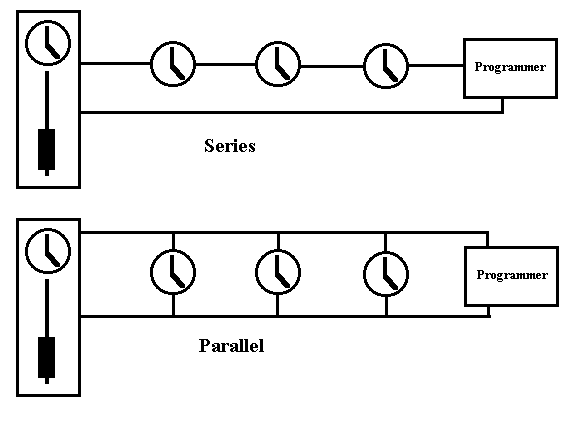
| Back to Home Page |
Master Clock Systems
Master clock systems consist of one accurate clock, usually in a secure room, and a number of slave dials which are driven by the master clock, thereby keeping all dials showing the same time. Such clock systems were developed in the early years of the 20th century and usually consisted of a one-second pendulum master clock that would produce electrical pulses either every second or every 30 or 60 seconds. Most systems installed in factories or schools only required accuracy to the minute or half minute, but broadcasting and telecommunications organisations required accuracy to the second.
The master clock and all the slave dials are connected together electrically,
either in a series loop, or in a parallel configuration. Slave dials for
use in a series loop will have a very low resistance (usually under 10
ohms), and dials for use in a parallel circuit will have a high resistance
(usually in excess of 3000 ohms). The advantage of a parallel system is
that dials can be removed or added to the system without affecting the
operation of the other dials. In a series system, a shorting link is inserted
in place of a slave dial while that dial is removed and repaired. This
will upset the total current flowing through the circuit, but should not
stop the system working.

Earlier systems used pulses of the same polarity to drive the slave dials. Slave dials were simpler to build this way, but the whole system was subject to spurious pulses advancing the slaves. Later systems used alternating polarity pulses where each pulse is of the opposite polarity to the previous pulse. This meant that another pulse of the same polarity sent in error would not advance the slave dials.
As well as slave dials, programmer devices could be added to the system that sounded bells or sirens, or started other electrical apparatus at pre-determined times each day (e.g. bells in a school to indicate changes of class).
Modern master/slave systems now use radio controlled slaves (see radio
controlled clocks) running from a Nationally serviced radio transmission,
or use a local digital time signal that can be superimposed on the mains
electricity supply, with slave dials detecting the time signal from the
power line.
| Back to Home Page |